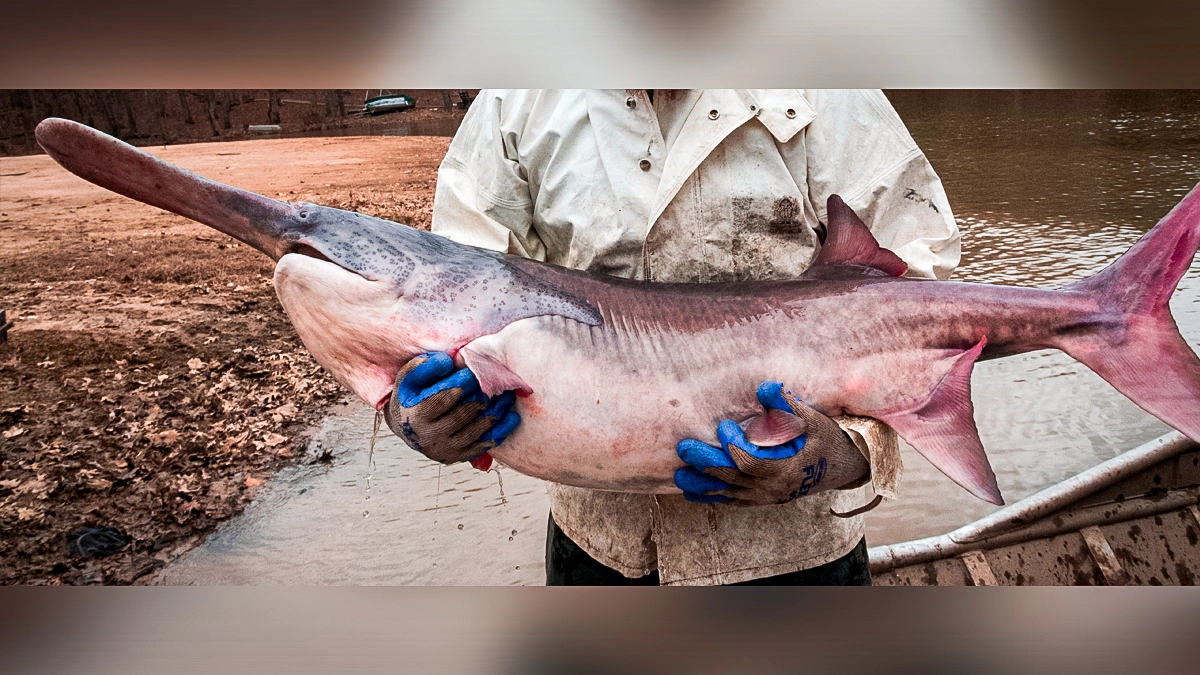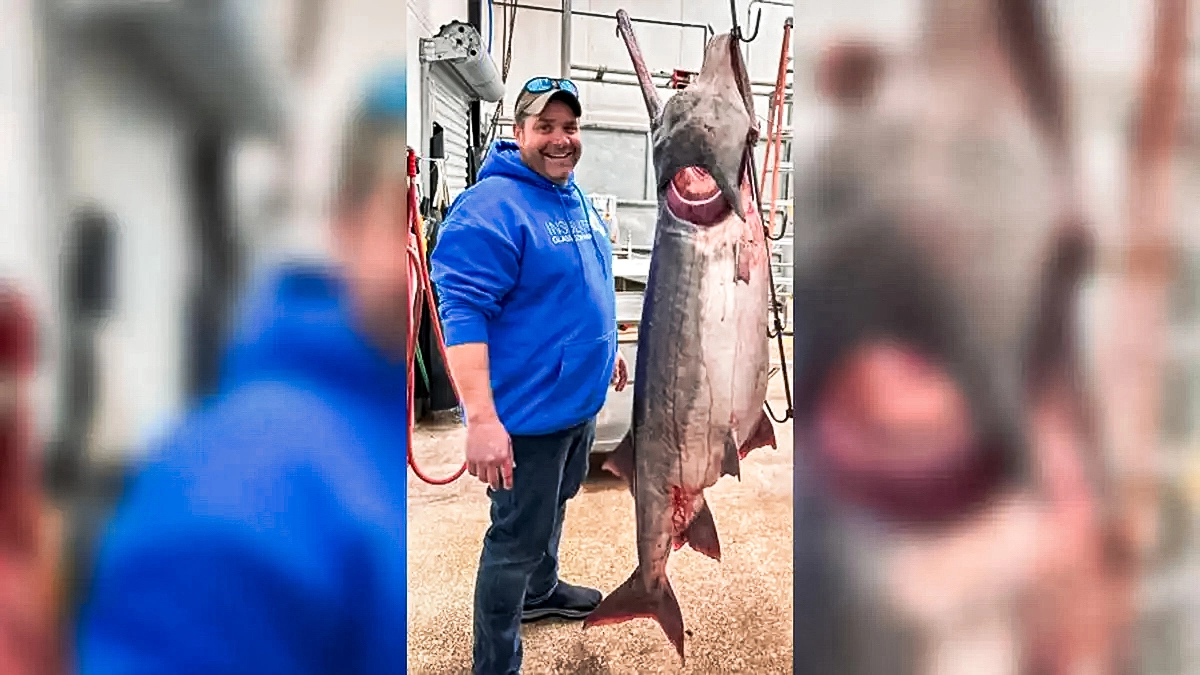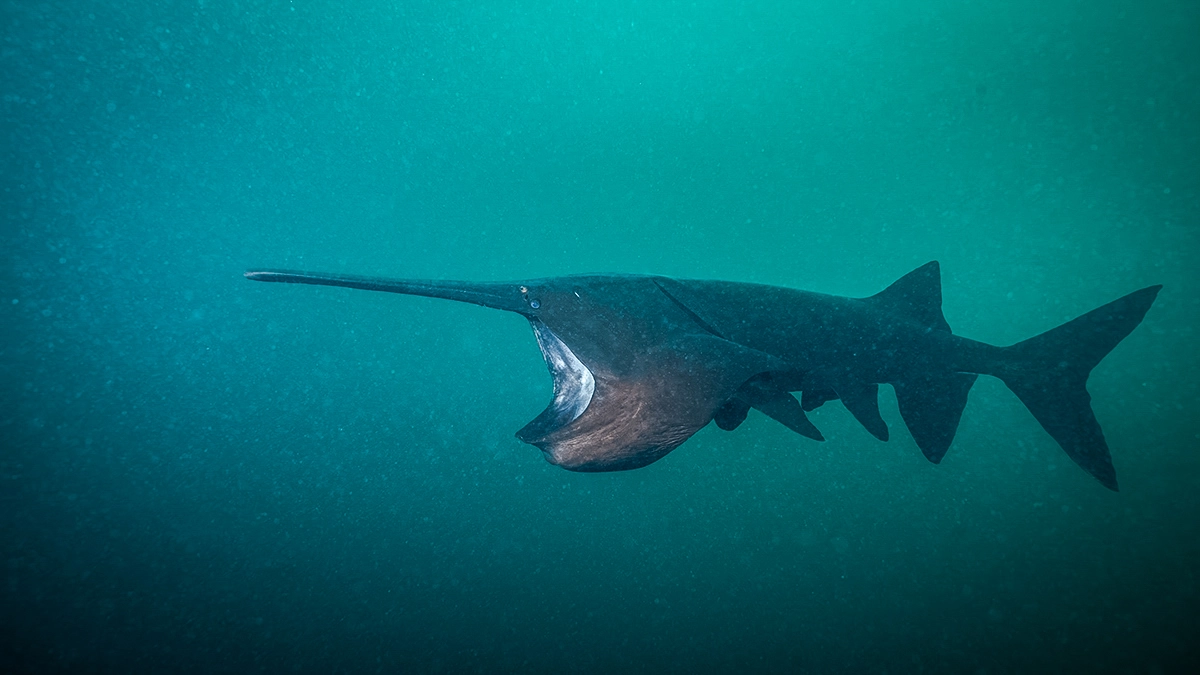What if I told you there was a freshwater fish in North America with smooth skin and cartilage instead of bone? No, it’s not a lamprey or shark that migrated up a river. We’re talking about paddlefish, one of the largest and oldest North American freshwater species.
History of the Paddlefish
Paddlefish were first described by marine biologist and ichthyologist Johann Julius Walbaum in the late 1700s.
Paddlefish (Polyodon spatula) are one of North America’s most distinctive freshwater fish species. They are a member of the Acipenseriformes order, which contains only one other species: sturgeon. After the extinction of the Chinese paddlefish, they are the only surviving member of the Polyodontidae family.
The ray-finned fish, which is estimated to be nearly 300 million years old, is also known as a spoonbill cat, spoonbill, Spatula, Shovelnose, Shovelnose cat, American paddlefish, and Mississippi paddlefish.

How To Identify Paddlefish
Identifying a paddlefish when it’s out of the water is easy; they have one of the most distinctive facial features of any fish: their rostrums or noses. The elongated rostrum, often called a spoonbill, is the critical feature for identifying a paddlefish and is where they get their name. It extends forward from the face up and can reach up to 7 feet in length; it’s rounded at the end, sort of like a paddle (get it?) or a beaver tail.
Paddlefish eyes are small and located at the base of the rostrum, facing down and forward rather than to the sides. Another distinct feature unique to paddlefish is their operculum, or gill flap. Unlike other fish, paddlefish have an abnormally long operculum that extends past their pectoral fins and tapers off to a point. The operculum also has a distinct spotted pattern down the side of the gill flap.
An Ancient Fish, For Sure
When first discovered, the paddlefish was classified as a shark. While that classification proved inaccurate, paddlefish and sharks share some characteristics. Like a shark’s, the tailfin of a paddlefish is deeply forked and the top fin is slightly larger than the bottom. And, as mentioned above, a paddlefish skeleton is made of cartilage instead of bone, like a shark. That’s about all they have in common.
Paddlefish lack teeth and instead have specialized “gill rakers” that allow them to filter feed. If you ever have the opportunity to see them gliding through the water, feeding with their enormous mouths and flared gills; it will be something you will never forget.

Unlike the gritty sandpaper texture of shark skin, the skin of a paddlefish is smooth and primarily scaleless. The only scales on a paddlefish are in a small area by the tailfin.
Their coloring will often range from blue to gray with a white belly.
Where To Find Paddlefish in the U.S.
North American paddlefish can be found in the Mississippi River basin and in the Missouri River as far north as Montana. They inhabit many different parts of the river system, including the free-flowing river, braided channels, backwaters, and even oxbow lakes.
Currently, paddlefish can be found in 22 states; 15 states stock them in reservoirs, including Arkansas, Illinois, Iowa, Indiana, Kentucky, Mississippi, Missouri, Tennessee, South Dakota, West Virginia, Oklahoma, Minnesota, North Dakota, and Wisconsin. Paddlefish can also be found in the Gulf of Mexico drainages from Texas to Alabama.
That said, overfishing and habitat loss due to development and pollution have caused paddlefish populations to decline sharply in recent years and their range to shrink. Construction of dams have blocked their season upward migration to ancestral spawning grounds, further impacting paddlefish numbers.
Paddlefish Spawning

Spring showers are essential for paddlefish. An increase in flow and water levels from rain signals paddlefish to begin their journey to find their spawning habitat. The criteria for successful paddlefish spawning are more challenging to achieve annually than those required by bass, catfish, or sunfish. Water level, current, water temperature, duration of sunlight, and substrate material must all align to provide paddlefish with a successful spawning season.
Paddlefish spawn in schools through a process known as broadcast spawning. Broadcast spawning allows female paddlefish to release their eggs into the water and settle on the substrate below. As female paddlefish expel their eggs, male paddlefish will broadcast milt into the water above the eggs to fertilize them. Once fertilization has occurred, eggs will attach to the rock and sandy substrate, where they will stay until the eggs hatch.
Upon hatching, the young paddlefish will not experience any parental care. As the fry begin to leave the gravel spawning beds, it is common for them to be carried via current to deeper pools with less current, where food will drift to them.
Lifespan and Size

Upon hatching, paddlefish fry will grow rapidly over the first six months to a year. Typically, they will be 12 to 14 inches long after about a year of growth. However, if conditions are right, they can sometimes grow up to 20 inches within the first year. As they continue to mature, their growth slows down and by the time they are five years old, they will average 2 inches of growth per year.
Paddlefish reach sexual maturity between seven and 10 years of age. Adults can reach up to 7 feet in length and weigh as much as 200 pounds. Larger fish over 40 pounds are often female and can be up to 40 years old with an average age of 27 years. Conversely, males don’t usually grow larger than 40-pounds with an average age of 20.
The current world record paddlefish was caught on the Lake of the Ozarks in Kansas earlier this year. It was snagged by Chad Williams of Olathe, Kansas, on March 17, 2024 and weighed in at a stunning 164 pounds 13 ounces. It easily broke the previous Kansas state record of 140 pounds and topped the old world record of 164 pounds even.
The extinct Chinese paddlefish are believed to have reached 23 feet in length and weighed close to 1,000 pounds.
Feeding Time
Paddlefish feed by swimming through the water column with their mouth open, occasionally thrashing from side to side to help filter tiny organisms into their gills, which is quite a sight to behold. Like some whales of the ocean, these large river fish primarily consume some of the smallest aquatic organisms called zooplankton, microscopic animals that feed on phytoplankton in the water column.

The fish have tiny sensory pores on the rostrum, the lower jaw, and the gill cover flap that allow them to detect the zooplankton’s electrical current in the water. The pores act as radar that detect and locate food. The sense is so powerful that even if the rostrum is damaged or lost due to a collision with a boat, a paddlefish can still find food.
Habitat and Population Threats
The best areas to find paddlefish are large, open areas with moderate currents. When feeding, they swim continuously searching for food and avoiding areas with large amounts of standing timber and aquatic vegetation. Reservoirs with areas where currents are coming in via river or stream can be great places to look for feeding fish. Since paddlefish filter-feed, the current from incoming water allows them to do so while expending less energy than if they were randomly foraging.
In the spring and summer, look for them in the tailwaters of dams due to their desire to swim upstream. Besides rivers and lakes, they can be found in streams, swamps, oxbows, and backwaters.
Paddlefish can be harder to find in rivers with various currents, pools, and substrates.
Dam installation to create reservoirs and flood control have prevented the fish from migrating to areas where they have historically spawned, which has led to a decrease in wild populations in their native range. Increased runoff and siltation have impacted spawning habitats by covering once great areas to spawn and forcing them to look elsewhere in the hopes of having a successful spawn.
Additionally, their eggs became sought after for caviar since an embargo on Beluga caviar was instituted in the 1980s. This makes the species the target of illegal poaching and egg selling. The species is also susceptible to over-harvesting in some areas due to the demand by commercial markets for their uniquely flavored meat and the increasing caviar business worldwide.
Since these fish continuously swim near the surface of the water looking for food, this can lead to accidental boat strikes. Paddlefish are not fast-moving fish and cannot avoid boats in cases where boats are streaking quickly across the water.
Interesting Paddlefish Facts
- They can regenerate tissues that have been damaged after boat strikes.
- They lack a swim bladder and must continuously move to avoid sinking.
- They are caught via snagging, because filter-feeding paddlefish do not bite traditional lures.
- The new pending IGFA world record weighed 164.13-pounds and was caught at Lake of the Ozarks in Missouri on March 17, 2024.
- The Missouri state fish is the channel catfish, but the state aquatic animal is the paddlefish












